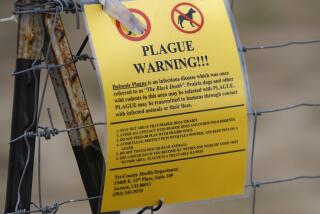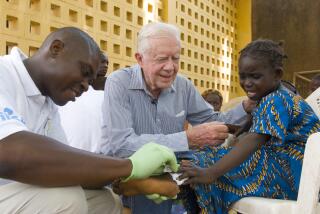Threat of Germ Warfare Brings a New, Frightening Equation to the Gulf Crisis : Military: Saddam Hussein has denied possessing such a stockpile. But the U.S. isn’t taking any chances.
With the possibility of a war in the Persian Gulf that could include chemical as well as conventional weapons, the specter of another fearsome weapon--germ warfare--has been raised.
The Pentagon said Friday that it is planning to vaccinate U.S. troops to protect them against possible biological warfare but refused to specify what vaccines would be administered or the germs that U.S. intelligence officials believe Iraq could unleash.
Iraqi President Saddam Hussein has repeatedly denied the existence of such a stockpile. However, there has been conjecture that typhoid, cholera, anthrax, botulism and tularemia are all part of the Iraqi disease arsenal.
Two months ago, CIA Director William H. Webster reported that Iraq possessed biological weapons. It was subsequently reported that U.S. intelligence analysts believed that the Iraqi military would be capable of using a substantial amount of germ weapons in combat after Jan. 1.
Because they bring on disease, germ warfare agents do not kill quickly, unlike the more lethal forms of chemical weapons, such as nerve gas. But the prospect of contracting such things as botulism on the battlefield can be intimidating to an army, so biological weapons can have a strong psychological effect.
Mustard gas, a form of chemical weapon, was used in World War I, and Iraq is widely believed to have used nerve gas during its war with Iran. But biological weapons are thought never to have been used in modern warfare.
International law forbids the use of both chemical and biological weapons, but a number of countries, including the United States, have conducted research into both sorts of weapons and how to defend against them.
How diseases might be spread among American soldiers and their allies--whether by air or through contaminated food and water supplies--is the subject of speculation, since much of the information is classified. Some of the diseases that could be spread by germ warfare, such as tularemia and anthrax, take effect more rapidly when the germs are inhaled than when they come in contact with the skin.
The tactic of neutralizing an army with sickness dates back centuries, when combatants would leave infected corpses in each other’s camps. Although vaccines and antibiotics today give a measure of protection, medical science has also provided the capability to blunt those tools. Vaccines, for example, may be rendered useless by the introduction of an organism that has been genetically altered in the laboratory to resist the protective effects of vaccination.
One potential drawback to the use of germs in warfare is that they can turn on the attackers, as well as on local civilian populations. Organisms released through the air, for example, don’t always fall precisely on the enemy, particularly if the wind shifts.
America’s main biological warfare facility is the Army’s Medical Research Institute of Infectious Diseases at Ft. Detrick, Md. A spokesmen contacted there Friday said the Pentagon had forbidden any release of information about the laboratory’s research.
Here is a look at some of the diseases that are generally thought to be part of the biological warfare arsenal.
Typhoid
This disease is characterized by high fever, headaches and a distinctive rash that is caused by the organism Salmonella typhi. People get it by eating contaminated food or drinking fouled water. Once ingested, the germ spreads through the bloodstream. Before antibiotics were available, about 10% of typhoid’s victims died of septic shock. With antibiotic treatment, the death rate is about 1%. There is a vaccine, but it is not considered effective against massive doses of the organism. Infected people can spread it to others through exposure to feces or urine.
Tularemia
This disease is a bacterial infection caused by the organism Francisella tularensis. Commonly, it is a disease of hunters exposed to the blood of infected animals. Deer flies or ticks can also be carriers. The incubation period is about three days. An ulcer and enlarged lymph nodes develop where the germs enter the skin. Without treatment, the infection spreads throughout the body in a manner similar to typhoid. Antibiotics cure most cases. Without antibiotic treatment, tularemia causes death in 5% to 10% of cases. The organism can also be ingested or inhaled. Only laboratory accidents have proven the latter possible, according to Dr. George W. Rutherford, an infectious disease expert with the California Department of Health Services.
Anthrax
This disease is caused by the organism Bacillus anthracis, which can enter the body through the skin, lungs or mouth. Usually, it is a disease of livestock. Most cases in humans develop through skin contact with the pelt of an infected animal. Symptoms generally develop in two to five days. With skin contact, the first sign is an ulcer that quickly turns into a black, pitting lesion. From there, the germ enters the bloodstream, causing systemic infection. When inhaled, B . anthracis rapidly produces systemic infection and pneumonia. With antibiotic treatment, most patients recover. Without antibiotics, the fatality rate is 15% to 20%. A vaccine exists that is effective against skin exposure, Rutherford said. Anthrax cannot be passed from person to person.
Botulism
This disease is caused by the toxin of an organism called Clostridium botulinum. It is almost always fatal, and the toxin is so potent that only a few ounces are needed to poison a water supply. It also works quickly, producing symptoms in 12 to 36 hours. Blurred vision and a dry mouth are the first signs, followed by rapidly developing paralysis as the toxin attacks the nerves that send messages to muscles. Victims die because the muscles responsible for breathing cease to work. The treatment is antitoxin, which acts to neutralize the toxin floating in the bloodstream. Patients often must be kept alive on respirators to give the antitoxin time to work. An experimental vaccine is in development, according to Rutherford. The toxin must be ingested through food or water.
Cholera
Cholera is caused by the vibrio cholerae organism. People get infected through contaminated food or water. The germ produces severe diarrhea two to three days after exposure, which leads to life-threatening dehydration. The treatment is supportive therapy, mainly replacing the fluids the patient looses through diarrhea. There is a vaccine, but it is only about 50% effective. A better vaccine is in development.
Times staff writer Douglas Jehl in Washington contributed to this article.
More to Read
Sign up for Essential California
The most important California stories and recommendations in your inbox every morning.
You may occasionally receive promotional content from the Los Angeles Times.










